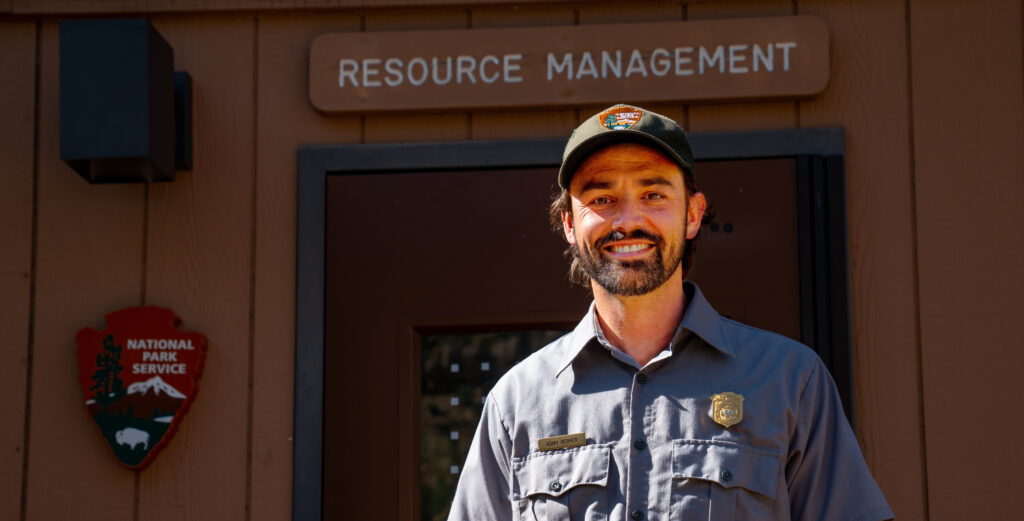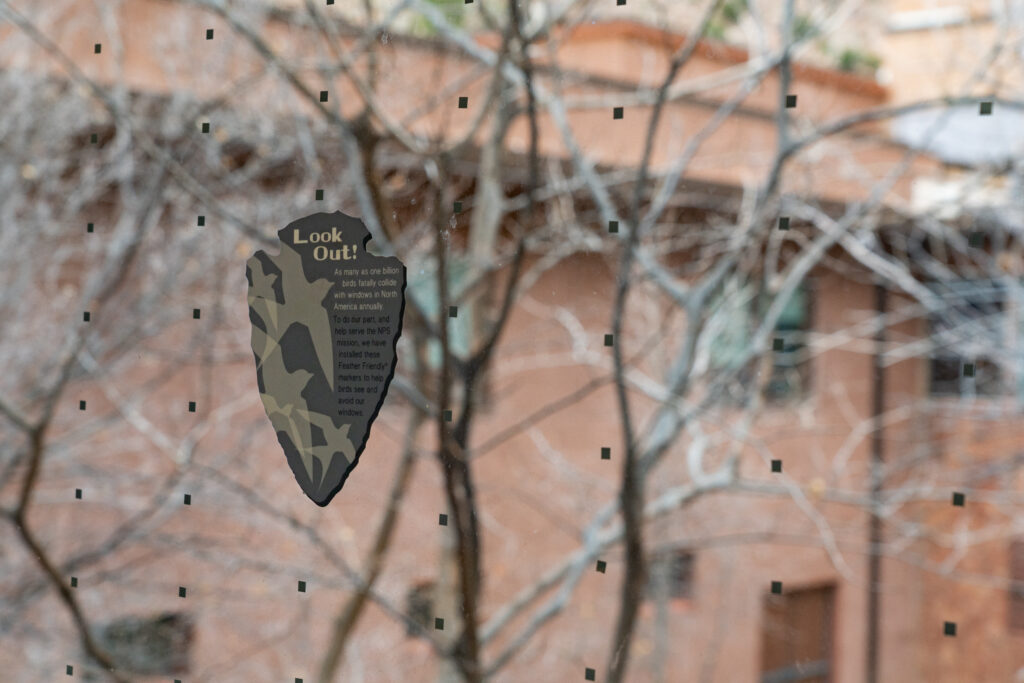Fenestration: Reflecting More Than Zion
Bird-Friendly Windows at Zion National Park in Utah
by Adam Reimer, wildlife biologist, Zion National Park, National Park Service

The views in Zion National Park are spectacular and not to be missed. The landscape is a stunning panorama of sandstone towers, temples, peaks, and pillars. It is no wonder that the building designs feature massive picture windows and glass doors so as not to deprive the visitors or staff of a moment of breathtaking landscape. But there is a hidden danger lurking within these transparent surfaces. Humans are becoming increasingly aware of the dramatic impact that our glass doors and windows are having on bird populations.
As many as one billion birds die from glass collisions every year just in the United States. To complicate matters in places like Zion, the trend is toward designs that fit seamlessly into the landscape, incorporating earth tones and landscaping with natural and native vegetation. While aesthetically pleasing to the human eye, these design practices further blur the lines between structure and habitat for the bird’s eye. While it is embarrassing when humans miss cues like window frames and thresholds that identify an impending glass collision, for birds it can be deadly.

In 2019, former Zion employee, Jason Pietrzak, brought awareness of the window-strike issue to Zion. Pietrzak had a background surveying buildings, powerlines, and other man-made structures for bird mortalities, so being called out for dead and injured birds in the park was familiar territory. Utilizing funds provided through Zion’s non-profit partner, Zion Forever Project, Zion wildlife biologists tested several products to make windows more visible to birds.
In the spring of 2020, volunteers and wildlife staff began installing a variety of collision-avoidance stickers on the windows of employee housing. They added rows of ½” perforated squares, dots, and tapes to the windows of one employee residential area. Employees in another housing area looked on as their windows were treated with ¼” light gray squares from another manufacturer. The park’s wildlife staff got crafty as well, finger painting windows of the Emergency Operations Center (EOC). This wave of effort would only bring the total treated glass surfaces in the park to around 15%, and even less when the acrylic paint was removed from the EOC following the fall bird migration.
In the summer of 2021, a serendipitous phone call from Dr. Christine Sheppard of the American Bird Conservancy connected Zion with yet another manufacturer of collision avoidance stickers. They needed a field study, and Zion was in the market for more coverage. With the necessary environmental research and compliance work in place, all that was needed was approval from the Cultural Resources Program and Law Enforcement Division to treat the EOC and the historic Zion Nature Center. The product they installed was temporary, so it did not affect the historic nature of the culturally significant structures, and it is optically clear so that it has only a small effect on views for humans. Roughly 2,000 sq.ft. of this product was installed in the spring of 2022, bringing the total coverage to 38% of the glass surfaces in the whole of Zion.

Some major keys to success have been identified in Zion’s journey to be collision free, and the staff is certainly still learning. A standardized monitoring protocol was put into place in the fall of 2021. Wildlife staff conduct bi-weekly inspections of treated buildings using a mobile data collection app and visually inspecting windows for collision prints and the surrounding area for dead or injured birds. To date, there have been no window strikes reported on treated windows. Staff park-wide have also been notified to contact the park’s wildlife biologist if they find dead or injured birds or hear a collision. Window collisions can be extremely difficult to detect so the more eyes and ears, the better. Every strike that is detected is entered into the mobile app’s database. Zion is also increasing the visibility of its efforts by focusing on treating areas with high public use. With around five million visitors to the park annually, Zion has the perfect opportunity to increase its outreach efforts and bring attention to protecting birds from window strikes.
The park’s focus moving into the future, in addition to securing more funding to expand its treatments, is on ensuring that new construction in the park incorporates bird-friendly design. Adhesives will only last so long, so Zion is considering other treatments. One alternative for new construction is to use pre-treated glass or frosted glass. Another option is to install insect screen or shade screen. Screens obscure the reflective exterior of the window reducing territorial aggression sometimes seen in nesting season and preventing collisions. As an added benefit, screens keep out insects and can reduce solar gain, keeping the interior of the structure cooler. The drawbacks are that screens often need to be custom made to fit the size of the window, they can be costly, and they are not always appropriate for maintaining the historic character of the culturally significant buildings in the park.
There still is a long way to go to reach the goal of 100% bird-friendly glass in Zion, but the park continues to make progress. No matter what solution is chosen to prevent window collisions, the fundamentals of the application are what is most important. The question to answer is, “Does the application achieve the end goal of preventing bird strikes?” Whatever solution you choose, those little orange and black dots in pre-treated windows, the tiny gray square stickers, or the tempera paint that you and the kids finger painted on should be a point of pride. You are doing something to help, even if it is just one bird.